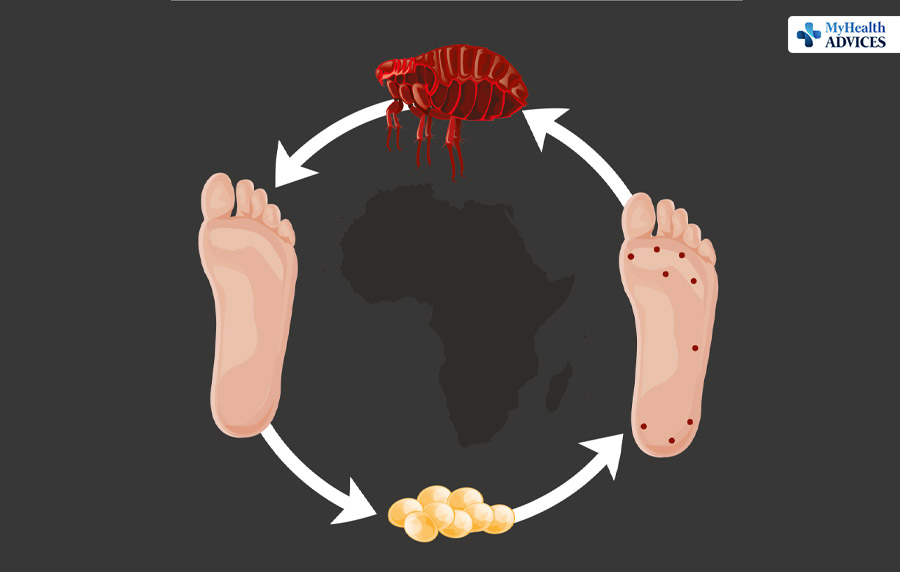Sand fleas, however minuscule, can sneak up suddenly with their bites, leaving many pondering their impact. In this article, we dive into the universe of sand fleas, exploring what they are, the effects of their bites, whether they are edible, and how to perceive if they’ve settled under your skin.
What Are Sand Fleas?

Sand fleas, scientifically known as Tunga penetrans, are parasitic insects tracked down in sandy coastal locales all over the planet. Regardless of their name, they are false fleas yet rather have a place with the flea family. These minuscule creatures, estimating a couple of millimeters, flourish in warm, sandy conditions, making sea shores and coastal areas their favored living space.
How Does Sand Fleas Bites Looks Like?

Sand fleas bites can be irksome and in some cases excruciating. At the point when these little nuisances bite, they puncture the skin to benefit from blood. Their bites often bring about bothersome, red knocks looking like mosquito bites. In spite of the fact that sand flea bites are generally innocuous, scratching them unnecessarily can prompt optional contaminations.
Can You Eat Sand Fleas?

While sand fleas might appear to be captivating because of their overflow in coastal districts, they are not regularly eaten as food by people. Eating sand fleas isn’t prescribed because of potential health gambles related with ingesting parasites or harmful bacteria that might dwell inside them.
Fauci Beagles and Sand Fleas
The notice of fauci beagles sand fleas according to the ignited discussion lately. However, isolating truth from fiction is significant. Fauci Beagles are canines utilized in laboratory research, and there is no immediate connection among them and sand fleas past hypothesis and deception.
How to Tell If Sand Fleas Are Under Your Skin
Identifying whether sand fleas have tunneled under your skin can be a challenge. However, there are signs to look for. Steady tingling, redness, and little knocks in areas where sand fleas are pervasive may demonstrate their presence under your skin. Looking for clinical consideration is fitting if you suspect sand fleas have attacked your skin.
Effects of Sand Flea Bites

While most sand flea bites cause minor distress, now and again, they can prompt more extreme responses, like unfavorably susceptible responses or diseases. People with delicate skin or compromised invulnerable systems might encounter elevated symptoms and ought to play it safe to stay away from sand flea bites.
How To Prevent Sand Flea Bites?
To limit the gamble of sand flea bites, a few preventive measures can be taken. Abstain from sitting straightforwardly on sandy areas, particularly during top sand flea movement times. Applying bug repellent containing DEET to uncovered skin can likewise dissuade sand fleas. Moreover, wearing long sleeves and jeans while wandering into sandy conditions gives an additional layer of protection.
Exploring Sand Flea Habitats
Sand fleas flourish in warm, sandy conditions, especially in coastal districts with more than adequate sand and moderate temperatures. Their favored habitats incorporate sea shores, sand rises, and sandy soil close to water bodies. These areas give the best circumstances to sand fleas to raise and benefit from the blood of well evolved creatures, including people and homegrown creatures.
Understanding Sand Flea Behavior
Sand fleas are nighttime creatures, meaning they are generally dynamic during the night and evening time hours. This behavior permits them to stay away from direct daylight and high temperatures, which can be inconvenient to their endurance. During the day, sand fleas tunnel into the sand to get away from the heat and arise around evening time to look for hosts for blood dinners.
Lifecycle Of Sand Fleas
The lifecycle of sand fleas comprises a few phases, including egg, hatchling, pupa, and grown-up. Female sand fleas lay their eggs in sandy soil, where they hatch into hatchlings. The hatchlings then, at that point, form into pupae prior to arising as grown-up sand fleas. This life cycle commonly requires a little while to finish, contingent upon environmental circumstances like temperature and stickiness.
Ecological Role Of Sand Fleas
While sand fleas are often seen as irritations because of their bites, they likewise assume a part in the biological system. As parasites, sand fleas assist with directing populaces of specific host species, like rodents and little well evolved creatures, by benefiting from their blood. Moreover, sand fleas act as a food hotspot for different predators, including birds, reptiles, and different insects.
Traditional Uses Of Sand Fleas
In certain societies, sand fleas have traditional uses past their role as vermin. For instance, in specific districts, dried sand fleas have been utilized in society medication for treating different diseases, including skin conditions and contaminations. However, the adequacy and wellbeing of such practices have not been scientifically approved and may present dangers to health.
Environmental Impact of Sand Fleas
While sand fleas are a natural piece of coastal ecosystems, human exercises can some of the time compound their populaces and impact local conditions. Contamination, environment annihilation, and environmental change can adjust sand flea habitats and disturb their natural offset with different species. Understanding the ecological elements of sand fleas is fundamental for saving coastal biodiversity.
Management and Control of Sand Fleas
Overseeing sand flea populaces can be trying because of their prolific rearing and versatile nature. Incorporated bug management systems, including environmental modifications, chemical control methods, and public education campaigns, can assist with moderating sand flea perversions and lessen their impact on human health and prosperity.
Conclusion
Sand fleas, however little in size, can prominently affect beachgoers and occupants of coastal areas. Understanding the idea of sand fleas, the effects of their bites, and methods for preventing and identifying their presence can assist with alleviating possible uneasiness and health chances related with these bothersome parasites.
Also Read
- Anxiety: Signs, Symptoms, Causes, Prevention
- Bug Bites: Sign, Symptoms, Causes, Prevention
- Autism: Signs, Symptoms, And Causes
Feature image source:- http://tinyurl.com/huccu4mc


